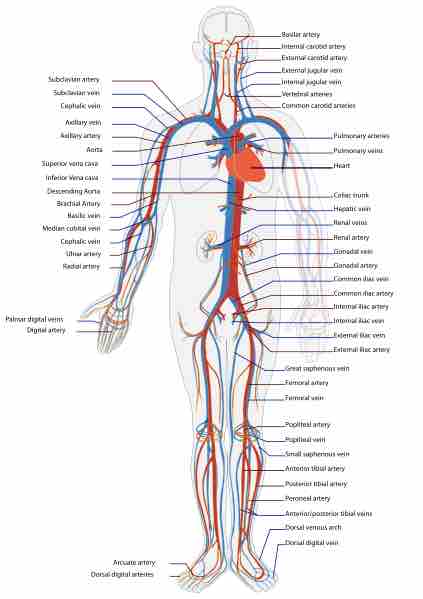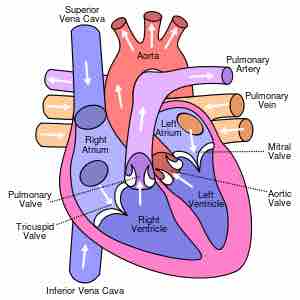How Blood Flows Through the Body
As the heart pumps, blood is pushed through the body through the entire circulatory system . Oxygenated blood is pumped away from the heart to the rest of the body, while deoxygenated blood is pumped to the lungs where it is reoxygenated before returning to the heart.

Circulatory system
This illustration of the circulatory system shows where blood flows in the body. Red indicates oxygenated blood, while blue indicates deoxygenated blood.
Blood Flow Away from the Heart
With each rhythmic pump of the heart, blood is pushed under high pressure and velocity away from the heart, initially along the main artery, the aorta . In the aorta, the blood travels at 30 cm/sec. From the aorta, blood flows into the arteries and arterioles and, ultimately, to the capillary beds. As it reaches the capillary beds, the rate of flow is dramatically (one-thousand times) slower than the rate of flow in the aorta. While the diameter of each individual arteriole and capillary is far narrower than the diameter of the aorta, the rate is actually slower due to the overall diameter of all the combined capillaries being far greater than the diameter of the individual aorta.

View of the heart
This front view of the heart shows the direction of blood flow to and from the heart. Blood leaves the heart through the pulmonary artery and aorta, while blood enters the heart through the two venae cavae and pulmonary veins.
The slow rate of travel through the capillary beds, which reach almost every cell in the body, assists with gas (especially oxygen and carbon dioxide) and nutrient exchange. Blood flow through the capillary beds is regulated depending on the body's needs and is directed by nerve and hormone signals. For example, after a large meal, most of the blood is diverted to the stomach by vasodilation (widening) of vessels of the digestive system and vasoconstriction (narrowing) of other vessels. During exercise, blood is diverted to the skeletal muscles through vasodilation, while blood to the digestive system would be lessened through vasoconstriction. The blood entering some capillary beds is controlled by small muscles called precapillary sphincters . A sphincter is a ringlike band of muscle that surrounds a bodily opening, constricting and relaxing as required for normal physiological functioning. If the precapillary sphincters are open, the blood will flow into the associated branches of the capillary bed. If all of the sphincters are closed, then the blood will flow directly from the arteriole to the venule through the thoroughfare channel. These muscles allow the body to precisely control when capillary beds receive blood flow. At any given moment, only about 5-10 percent of our capillary beds actually have blood flowing through them.

Precapillary sphincters
(a) Precapillary sphincters are rings of smooth muscle that regulate the flow of blood through capillaries; they help control the blood flow to where it is needed. (b) Valves in the veins prevent blood from moving backward.
Blood Flow to the Heart
After the blood has passed through the capillary beds, it enters the venules, veins, and finally the two main venae cavae (singular, vena cava) that take blood back to the heart. The flow rate increases again, but is still much slower than the initial rate in the aorta. Blood primarily moves in the veins by the rhythmic movement of smooth muscle in the vessel wall and by the action of the skeletal muscle as the body moves. Because most veins must move blood against the pull of gravity, blood is prevented from flowing backward in the veins by one-way valves. Thus, because skeletal muscle contraction aids in venous blood flow, it is important to get up and move frequently after long periods of sitting so that blood will not pool in the extremities.